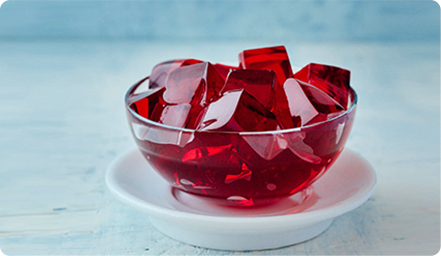-
July, 26,2025
Understanding the Role of Bloom Strength in Soft Gelatin Capsules
-
July, 25,2025
Bloom Strength and Its Impact on Hard Gelatin Capsules
-
July, 21,2025
How Gelatin Is Revolutionizing Pet Food: A Healthier Option for Dogs
-
June, 22,2025
Collagen as a Trusted Ingredient: Meeting Global Demand with Reliable Supply
Gelatin for Hot and Cold Use: How to Make the Most of Its Versatility
Gelatin performs differently in hot and cold recipes, but knowing how to use it properly unlocks its full potential. Whether you're working with desserts or savory dishes, this guide explains how to choose and apply the right gelatin. Backed by insights from FNP Gelatin, a trusted gelatin manufacturer, you'll learn how to optimize results across all temperatures.
What Is Gelatin and Why Is It So Versatile?
Gelatin is one of the most multifunctional ingredients in the food and pharmaceutical industries. Derived from collagen found in animal connective tissues, this natural protein forms thermo-reversible gels, meaning it can melt when heated and solidify again upon cooling. This unique characteristic makes it invaluable in a wide range of hot and cold applications—from soups and sauces to jellies and mousse.
At its core, gelatin is prized for its ability to transform liquids into stable textures, improve mouthfeel, and enhance beverage clarity. Whether preparing a silky panna cotta or clarifying a consommé, gelatin delivers the right consistency with minimal additives.
The Natural Origin and Composition of Gelatin
Produced through partial hydrolysis of collagen, gelatin is classified as a clean-label, animal-based ingredient. The two most common forms are powdered gelatin and sheet gelatin, both of which must be hydrated and dissolved before use. A key performance factor in gelatin is Bloom strength, which measures the firmness of the final gel. This value can range from low (approx. 80 Bloom) to high (above 250 Bloom), with higher Bloom values offering firmer textures and faster setting times.
Functional Properties That Adapt to Temperature
Gelatin’s thermosensitivity allows it to dissolve easily in hot water (above 50°C or 122°F) and gel when cooled to around 10°C (50°F) or below. It’s also reversible—reheating a gel will return it to liquid form. These features make it an adaptable gelling agent for both hot dishes and chilled desserts. It also exhibits excellent film-forming, emulsifying, and stabilizing properties, which food developers can harness across temperature ranges.
Industrial vs Culinary Use Cases
In commercial food production, gelatin is used not only for its culinary versatility but also for technical benefits like foaming, encapsulating, and controlling water activity. For example, an edible gelatin manufacturer might formulate specific grades tailored to dairy, confectionery, or beverage applications.
As a trusted gelatin supplier, FNP Gelatin offers both high-Bloom and specialty formulations to meet the varying needs of professional chefs, food scientists, and B2B buyers. Whether you're sourcing from a gelatin manufacturer for mass production or selecting from an edible gelatin supplier for custom food formulations, product consistency and temperature performance are critical.
Gelatin in Hot Applications: Stability Meets Texture
Using gelatin in hot applications requires understanding how it behaves under heat and how to use it to your advantage. When applied correctly, gelatin not only survives cooking temperatures but enhances texture, mouthfeel, and even product shelf life.
How Gelatin Behaves in Heated Recipes
Gelatin begins to dissolve at around 50–60°C (122–140°F), and its complete solubilization typically occurs by 70°C (158°F). However, extended exposure to temperatures above 100°C (212°F) can degrade its gelling ability due to hydrolysis, especially if the pH is too acidic or alkaline.
For most culinary and industrial purposes, gelatin is first “bloomed” in cold water, then gently heated to dissolve without denaturing. Once incorporated into a hot liquid, it distributes evenly, creating a smooth, stable consistency upon cooling.
Best Uses in Hot Dishes
In hot applications, gelatin plays a key role in:
- Clarifying soups and broths through gelatin-assisted stock clarification
- Creating mirror glazes with a glossy, elastic texture that stays smooth even after reheating
- Making hot sauces or reductions more viscous without starch or flour
- Forming stable soft candies that melt smoothly in the mouth
- Enhancing processed meats and aspics, where thermal tolerance and gel elasticity are essential
Food professionals often turn to a gelatin manufacturer for specific high-Bloom gelatin designed to retain structure even after brief boiling or pasteurization. For example, FNP Gelatin offers functional gelatin types that are ideal for hot-fill systems and thermal processing lines.
Tips for Maximizing Performance in High-Heat Settings
To ensure your gelatin works well under heat:
- Hydrate properly before heating—never add dry gelatin directly into hot liquid
- Use the right Bloom strength—higher Bloom gelatin provides better structure for heat-sensitive recipes
- Monitor cooking temperature—avoid boiling gelatin-containing mixtures for extended periods
- Combine with stabilizers when needed—some industrial products mix gelatin with starches or gums for added resilience
Whether you’re a chef or a food product developer, selecting gelatin from a reliable edible gelatin manufacturer ensures your ingredients behave predictably at every stage of heat application.
Gelatin in Cold Applications: Setting Smooth, Firm Gels
Cold-set applications are where gelatin truly shines. Its ability to form clean, elastic gels without the need for chemical additives makes it ideal for refrigerated or ambient-temperature foods. From glossy fruit jellies to creamy mousse, gelatin enables consistent results when used correctly.
How Temperature Affects Gel Formation
Once dissolved in a hot liquid, gelatin begins to gel as the mixture cools, typically below 20°C (68°F), with full setting achieved around 4–10°C (39–50°F). Gelation time depends on the Bloom strength, concentration, and the presence of other ingredients (like sugar or acid).
The gel formed is thermo-reversible, meaning it can melt and reset multiple times without breaking down—an essential trait for both professional kitchens and industrial-scale production.
Common Cold Uses in Culinary and Industry
In chilled or ambient settings, gelatin is widely used to create:
- Jellies and aspics for meats, fruits, and vegetables
- Creamy desserts such as panna cotta, mousse, and bavarois
- Layered cakes and tortes where the texture contrast is key
- Yogurt and dairy-based snacks that need gelation without high heat
- Cold-set confections, including marshmallows and nougats
Edible gelatin suppliers often provide specific gelatin types suited for cold-set applications, where clarity, elasticity, and mouthfeel are critical. For example, FNP Gelatin formulates high-purity gelatin designed for smooth, transparent gels with excellent flavor release.
Preventing Texture Failures in Cold Environments
To ensure perfect results when using gelatin in cold recipes:
- Avoid freezing gelatin-based products, as freezing disrupts the gel matrix
- Allow enough setting time—typically 4–6 hours in refrigeration
- Use the right concentration—usually 0.5% to 2% depending on firmness desired
- Watch pH and alcohol content—strong acids and alcohol can weaken or inhibit gelation
Manufacturers seeking consistency across batches should work with a trusted gelatin supplier who provides technical support and documentation. FNP Gelatin, as a professional gelatin manufacturer, offers tailored recommendations based on cold-process requirements.
Choosing the Right Gelatin for Your Temperature Range
Not all gelatin is created equal—especially when it comes to performance across different temperatures. Choosing the appropriate type of gelatin for hot or cold use is critical to achieving the desired texture, setting speed, and product stability.
Understanding Bloom Strength and Temperature Compatibility
Bloom strength is a standardized measurement of gel firmness. It not only determines how firm the final product will be, but also influences setting temperature and melting point. Here's a general guide:
- Low Bloom (80–150 Bloom)
Softer gels, ideal for dairy-based products or soft textures at lower temperatures.
Suitable for applications that don’t require firm gel formation.
- Medium Bloom (150–200 Bloom)
Balanced strength and flexibility. Often used in desserts, marshmallows, and pharmaceutical capsules.
- High Bloom (200–300 Bloom)
Produces firm, elastic gels with higher thermal resistance.
Ideal for hot-fill systems, gummy candies, and meat jellies.
A reputable gelatin manufacturer like FNP Gelatin offers Bloom-specific grades to help food manufacturers match gel performance with exact formulation needs. Whether you're creating a delicate cold mousse or a stable glaze for hot pouring, Bloom strength matters.
Powdered vs Sheet Gelatin: Pros, Cons & Conversions
Both powdered and sheet gelatin function similarly, but their handling and measurement differ:
- Powdered Gelatin
Easy to measure and store. Preferred in industrial settings for scaling and precision.
- Sheet Gelatin (Leaf Gelatin)
Popular in culinary environments for its consistent strength and minimal flavor impact. Requires soaking and melting.
Conversion Tip:
One sheet of gelatin (standard silver grade) ≈ 1 teaspoon (approx. 2.5g) of powdered gelatin.
A quality edible gelatin supplier will often provide both forms, ensuring compatibility with different processing environments and regional preferences.
How to Match Gelatin Type with End Product Texture
Choosing the right gelatin is also about the desired outcome:
|
Desired Texture |
Recommended Bloom |
Ideal Use Temperature |
|
Soft, melt-in-mouth |
Low Bloom |
Cold |
|
Creamy but holds shape |
Medium Bloom |
Cold or warm |
|
Firm and elastic |
High Bloom |
Hot and cold |
|
Heat-resistant jelly |
High Bloom |
Hot-fill |
By working closely with an experienced edible gelatin manufacturer such as FNP Gelatin, businesses can access technical consultation and sample testing to select the ideal gelatin for each application scenario.
B2B Buyers: What Food Manufacturers Should Know
For food manufacturers, the choice of gelatin goes far beyond recipe development—it’s a strategic decision that affects product quality, scalability, and regulatory compliance. Partnering with the right gelatin manufacturer can streamline operations, ensure consistency, and support product innovation across hot and cold categories.
Thermal Stability Testing and Batch Consistency
In large-scale production, gelatin must perform consistently across batches and temperatures. Variability in Bloom strength, viscosity, or setting behavior can result in product failures, especially in heat-sensitive processes like:
- Pasteurization of dairy gels
- Hot-filling of confections
- Cold-set multi-layer desserts
Leading gelatin suppliers such as FNP Gelatin provide strict batch quality control, including:
- Certified Bloom strength ranges
- Verified microbial and chemical purity
- Application-specific performance testing
These measures help manufacturers reduce rework, optimize yield, and maintain product integrity across global markets.
Regulatory Standards and Clean-Label Needs
Today’s consumers are more ingredient-conscious than ever, and manufacturers must respond with clean-label, transparent formulations. That includes gelatin sourced from approved origins, processed without artificial additives, and certified to meet various dietary and cultural requirements.
When choosing an edible gelatin supplier, make sure they offer:
- Halal and Kosher certifications
- Allergen-free guarantees
- Traceability and batch documentation
- Compliance with food safety authorities like FDA, EFSA, or CFIA
FNP Gelatin, as a professional-grade gelatin manufacturer, is committed to clean-label production with comprehensive documentation support to ease audits and export processes.
Partnering with a Reliable Gelatin Supplier Like FNP Gelatin
Beyond providing raw materials, FNP Gelatin collaborates with manufacturers to co-develop solutions tailored for temperature-specific applications. Their services go beyond sales—they offer:
- Application testing for hot and cold recipes
- Custom Bloom formulations
- R&D partnership for new product development
- Scalable supply chains for consistent global delivery
Choosing a knowledgeable gelatin supplier isn’t just about sourcing an ingredient—it’s about gaining a technical partner who understands your formulation goals and market constraints.
Final Thoughts: Unlock the Full Potential of Gelatin in Any Temperature
Whether you're crafting a chilled fruit jelly or a heat-stable savory glaze, gelatin remains one of the most reliable and adaptable ingredients available. Its unique thermo-reversible gelling ability makes it indispensable across a wide spectrum of hot and cold food applications—from artisanal desserts to large-scale industrial products.
But successful outcomes depend on more than just the ingredient itself—they require the right grade, accurate usage, and a reliable gelatin supplier who understands your product's technical demands. That’s where working with a trusted gelatin manufacturer like FNP Gelatin makes a difference.
As a leading edible gelatin supplier, FNP Gelatin provides:
- Tailored Bloom strength options for different temperature ranges
- Clean-label, food-safe formulations with global certifications
- Technical support and consistent batch quality for scalable production
Whether you’re a food innovator, a manufacturer, or a product formulator, FNP Gelatin delivers not just gelatin, but confidence in every application.
Phone: +86-577-88105990
Mobile: +86-138 5886 1938
Official Website: www.fnp-gelatin.com
Email: sales@funingpu.com
Address: No. 1-10 Wenpu Road, Yacheng Town, Xiapu County, Ningde City, Fujian Province




